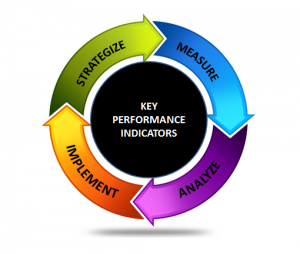10 Key Performance Indicators for SEO


When thinking about marketing and optimizing your business online, it can sometimes be a difficult task deciding which metrics you should be monitoring and how often you should be reviewing them. Certain campaigns like PPC can be simple to assess, while other organic efforts may be a little more challenging. Tracking SEO efforts is crucial, and we need to be doing it to assess our success and to determine what our next steps should be. Below are ten key performance indicators that we think are the most important and worth tracking.
Keyword Ranking
Why: Keyword research is most likely the basis for any SEO strategy and tracking ranking can be one of the best ways to determine if your keyword optimization efforts are paying off.
How: Carefully decide on keywords that you would like to rank for. While putting together your SEO strategy, create a simple benchmark report of where you are currently ranking, and begin tracking this weekly. If your efforts are successful, you should see positive movement.
Example:

ROI
Why: Return on investment tracking should not be the say-all-end-all KPI for your strategy, but it is one of the most objective ways to measure success and is often times seen as the most important. One thing to take into consideration is that a user could enter your site through an organic effort, but not take the desired action the first visit. They may remember your site, visit it directly, and convert in the future, making it difficult to track the attribution to your SEO efforts.
How: Revenue generated by efforts – SEO investment / SEO investment * 100= ROI
Example: 5,000 was invested into efforts, and 50,000 was generated: (50,000 – 5,000) / 5,000 * 100 = 900% ROI
Click Through Rate (CTR)
Why: So you’ve gotten your keywords to rank in a top position, that’s great! Now you must make sure your meta title and description are compelling enough to get that user to click the link to your site. Your meta title will be the actual text link that a user clicks to enter your site, and the meta description will be the short description that appears under the link. This should contain a clear sentence or two describing what your site is about and should contain your targeted keyword(s).
How: Using Google Webmasters, divide the amount of impressions (amount of times your site is shown in SERPS) for a particular keyword by the amount of clicks for that same link.
Example: The term “San Francisco dining” displayed your site on Google SERPS 115,000 times in the month of January. Out of those impressions, 2,500 users clicked through to your site: 2,500 / 115,000 * 100 = 2.1% CTR.
Conversion Rate
Why: Getting high rankings and a good CTR for your campaign are a good start. Now you need to make sure that visitors to your site are converting.
How: Look at the number of organic visitors to your site for a particular span of time and how many of those visitors actually completed the desired goal (became a member, purchased something, signed up etc.).
Example: Visitors for January were 45,000. Out of that 45,000, 1,250 filled out a form requesting a sales quote: 1,250 / 45,000 * 100 = 2.77% conversion rate
Percentage of Traffic Coming from Search
Why: Knowing how much of your traffic is coming from organic search can be a good determining factor of how your efforts are panning out.
How: Compare your total site traffic for a particular amount of time with traffic coming from organic search.
Example: Out of 50,000 total visitors and 36,500 came from organic search: 36,500 / 50,000 * 100 = 73%
Backlinks
Why: Remember, with backlinks, it’s quality over quantity! Having high quality, authoritative backlinks can help boost your domain authority which will in turn help your Google rankings.
How: Generate high quality content for your site that will not only appeal to your site visitors, but that will also entice others to link to it through appropriate anchor text.
Example: Guest post backlinks are highly effective. Reach out to a blog that relates to a similar interest to your site. Send the owner a message stating that you would like to help them add value to their site by creating unique content based around a mutual interest. In return ask for an appropriate outbound anchor link back to your site.
Branded VS Non-Branded Incoming Keywords
Why: If someone knows of your business or service they will find your site without a problem. Your optimization efforts should be towards organic, non-branded keywords to capture a user who may be looking for a service or product your business provides, but does not necessarily know about your company.
How: Using your analytics tool, look at branded v. non-branded keywords.
Example:Total visits to site are 8,500 and out of that 6,700 came in using organic non-branded keywords: 6,700 / 8,500 * 100 = 78%
Visitor Increase
Why: Visits to your site are crucial for your business, and your SEO efforts should include tracking monthly unique visitors. When assessing visits, remember that quality ranks high above quantity, and your SEO strategy should be to send the most qualified traffic to your site that will more likely result in a conversion.
How: Keep track of visits every month and compare numbers MOM & YOY. Make sure to take into consideration any seasonality that your business may suffer from.
Example:

Landing Pages Driving Traffic
Why: Looking at landing pages that drive traffic can give you an idea of how your optimization efforts are paying off, and how much exposure your site has in SERPS.
How: Find top landing pages for your site using your analytics tool. These pages can be seen as the gateway to the rest of you site. Focus optimization efforts on these pages and try to lower the bounce rate and convert more users. Also, over time you should strive to increase the amount of landing pages.
Example: Create a log of your landing pages that includes conversion and bounce rate, as well as number of keywords per landing page. Use this data as a benchmark as you work to increase landing pages, conversions and keywords, and reduce bounce rates.
Keywords Driving Traffic
Why: It’s no doubt you have spent a copious amount of time on your keyword research and optimizing your content and meta data following SEO best practices. Now you will need to track how many visitors you receive per keyword to help determine keyword performance.
How: Create a spread sheet with all your targeted keywords, and monitor the visits you get per keyword over time. Analyze metrics month over month, or year over year
Example:

Recent Posts
- Google Search Revolutionized for Educational Videos November 16, 2023
- Bidding Adieu to Google’s Page Experience Report November 9, 2023
- Google November 2023 Core Update November 3, 2023
- Unmasking Google’s October 2023 Spam Update October 5, 2023
- Unleash SEO Power: Must-Have Chrome Extensions for Website Success September 20, 2023
- SEO-Friendly URL Optimization: Mastering Structure for Better Ranking September 20, 2023
- Real Estate Marketing Ideas: Crafting a Results-Driven Marketing Strategy September 20, 2023
- The Anatomy of a Broken Link: Causes, Effects, and Solutions September 15, 2023
- Crafting an Informative FAQ Section: A Step-by-Step Guide September 14, 2023
- Local Business Schema Markup: Elevate Your Brand With The Magic September 14, 2023
Get
in Touch
Contact AdLift for a 360-degree marketing plan
